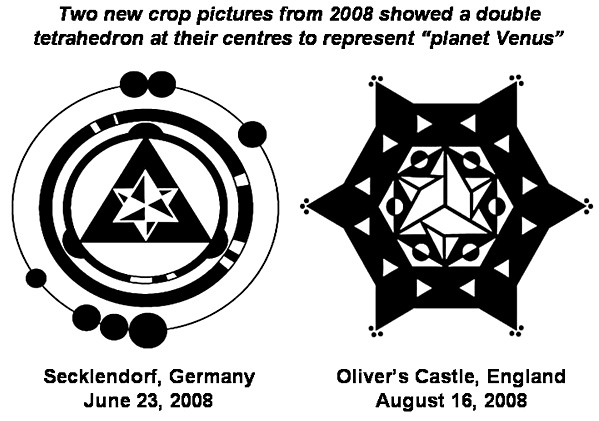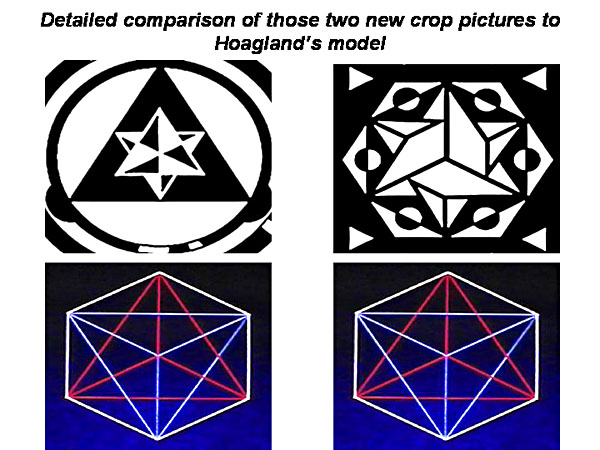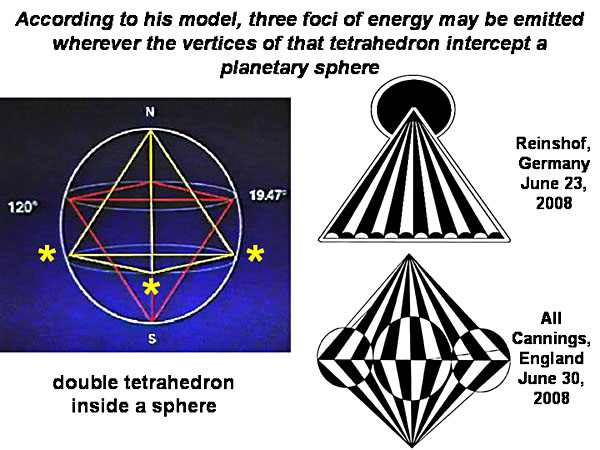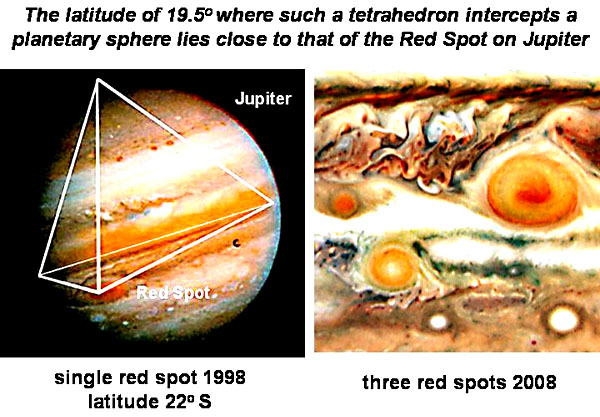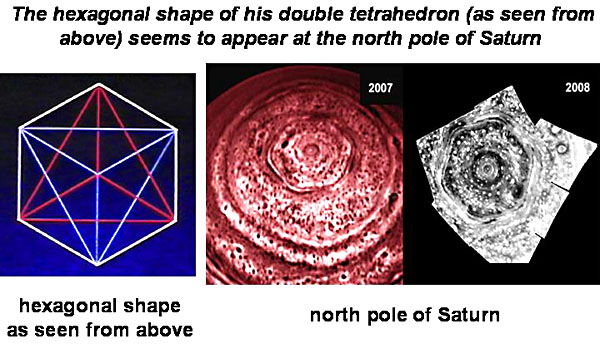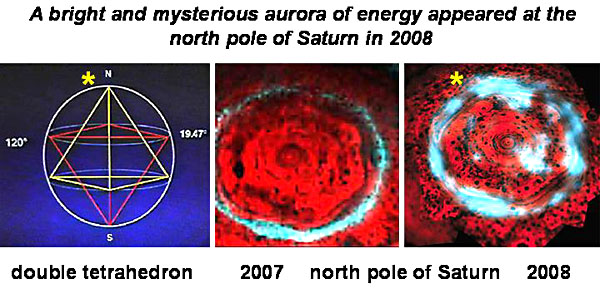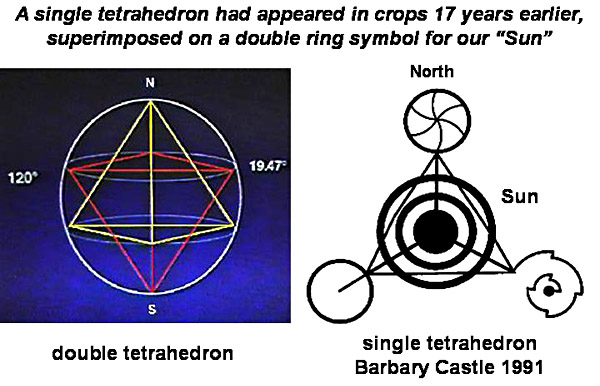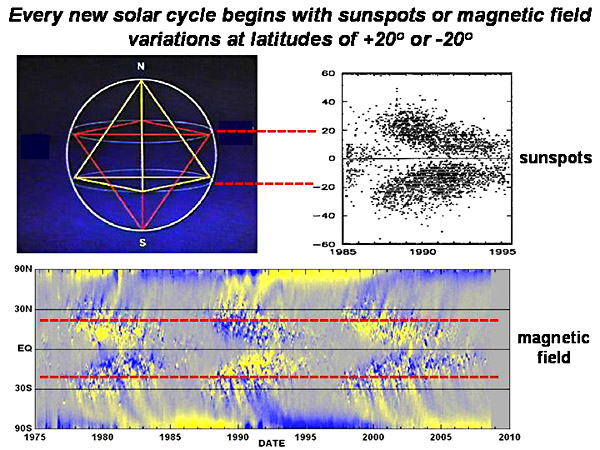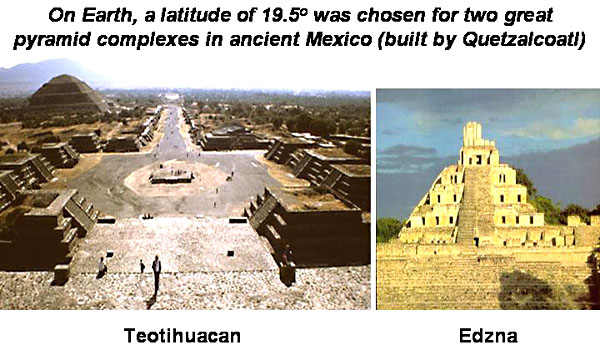|
Hyper-dimensional physics in English crop pictures: extra-terrestrial support for quantum gravity and the theories of Richard Hoagland?
Most of the fifty
or so paranormal crop pictures from last summer in
2008 dealt with solar or lunar eclipses (see
www.cropcircleconnector.com/2008/), a
highly accurate value for pi
as 3.141592654 (see
barbury2008a), or an end to the Mayan
Long Count calendar on December 23, 2012 (see
aveburymanor2008a). Two important
crop pictures from last summer, however, remain
incompletely explained.
Two
incompletely explained crop pictures from the summer
of 2008
The first of those appeared at Secklendorf, Germany
on June 23, 2008 (see
Secklendorf2008atml). Around the
outside it showed various planetary configurations
for Earth, Venus or Mars, leading up an end of the
Mayan Long Count calendar on December 21-23, 2012.
Then on the inside it showed a strange
three-dimensional prism shape to represent "planet
Venus":
The second of those appeared at Oliver's Castle,
England on August 16, 2008 (see
oliverscastle2008a). Around the
outside it showed various full cycles or half
cycles of Venus, leading up to an end of the
Mayan Sun-Venus calendar on March 28, 2013.
Then on the inside it showed the same strange,
three-dimensional prism shape, again to
represent "planet Venus".
Such a three-dimensional prism might in
principle be meant to represent "bright Venus",
shining brilliantly in the morning sky in early
August of 2008, when it rose from behind the
Sun. Yet further study suggests a more precise
interpretation, in terms of the symbols for
hyper-dimensional physics used by Richard
Hoagland and colleagues:
Symbols for hyper-dimensional physics According to Hoagland's novel theory of physics, every planet in our solar system (and the Sun) may contain a hyper-dimensional flow of energy within itself, that takes the shape of a double tetrahedron when viewed from around the equator, or the shape of a hexagon when viewed from above the north pole. How closely do Hoagland's models match the two prism shapes shown at Secklendorf or Oliver's Castle in the summer of 2008? Almost perfectly, as evidenced by the detailed comparisons provided below:
The double tetrahedron is
sometimes called a star tetrahedron or stella
octangula (see
Star Tetrahedron). Furthermore, the
details of its geometry when inscribed within a
sphere seem particularly interesting:
"If a tetrahedron is
placed inside of a sphere, with one vertex
located on the north or south pole, then
the resulting latitude of its other three
vertices will equal arcsin (1 / 3) or 19.47
degrees. Such tetrahedral geometry, when studied
on a solar or planetary scale, seems to
reveal an internal flow of energy at the centers
of large astronomical objects, out of higher
dimensions into our three-dimensional space"
(see
geometry or
esp_marte_4 or
planets).
An outward flow of energy at latitude 19.5 degrees Now as an important corollary to Hoagland's model, every planet in our solar system (or the Sun) should show three foci of outward energy flow at latitudes of 19.5 degrees above or below the equator, or else at the north and south poles, where those two imaginary tetrahedra intercept a spherical surface. That notable corollary seems to have been shown twice in crops last summer: first in partial form at Reinshof in Germany on June 23, 2008 (see Reinsdorf2008a, and then in complete form at All Cannings in England on June 30, 2008 (see allcannings2008a):
Reinshof of June 23 seems to be telling us that "energy is flowing outward from inside of planets or the Sun". Then All Cannings of June 30 seems to be telling us that such an outward flow of energy may lie at three particular foci on any planetary surface, separated in longitude by 120 degrees. The overall diameter of three expanded circles as shown at All Cannings was found on further analysis to match latitudes of plus or minus 20 degrees, thereby providing a reasonable match to arcsin (1 / 3) = 19.47 degrees from Hoagland's model. No other plausible interpretations of those four new crop pictures: Secklendorf of June 23, Reinshof of June 23, All Cannings of June 30, or Oliver's Castle of August 16, come to mind at present. Are we perhaps being shown specialized topics in planetary physics, from an extra-terrestrial science textbook? What do other Earth scientists think? Apart from any considerations of crop pictures, what do other scientists on Earth today think of Hoagland's theories? The vast majority seem to be either not knowledgeable, or else overwhelmingly sceptical! Indeed, before studying those four new crop pictures, I had never heard of Hoagland's proposals either.
"Richard Hoagland
and Thomas Bearden have proposed a new form of
physics that they call hyper-dimensional.
They believe that their new model represents the
original form of Maxwell's equations for
electromagnetism. They also argue that large
amounts of energy, originating from unseen
dimensions, may be emitted at latitudes 19.5°
south or north of the equator, on the Sun or
various planets in our solar system" (see
Richard C Hoagland or
Interplanetary Day After or
halexandria).
"Hyper-dimensional physics is a hypothesis
that energy may be stored in higher space
time dimensions than the three which we
seemingly inhabit. Richard Hoagland believes
that such energy may be focussed
on points located at the intersection
between a sphere and a tetrahedron: namely
at three points on any planet of
latitude 19.5°, plus one point of
latitude 90° (north pole). His hypothesis
has not been published in any peer-reviewed
journals, and remains unknown today to most
mainstream physicists" (see
Hyperdimensional
Physics).
A central vortex at Oliver's Castle in 2008 Yet does anybody really care what modern academics think? Or whether some new theory may or may not be deemed acceptable for their stuffy, dust-bound, library journals? The last word surely belongs to those mysterious crop artists, who seem to be trying to teach us advanced extra-terrestrial physics in English fields, although few people on Earth are currently listening. Here for example is part of a field report on Oliver's Castle by Janet Ossebaard, one of the more experienced investigators:
"The centre of Oliver's
Castle showed a stunning swirl
where its three central tracks
joined together. What struck me was the
way the crop had been swirled
around the centre. This was not
necessary, since that crop could more
simply have been pushed straight ahead,
then twisted into a central bundle. Yet
the outer right side of those tracks
flowed left as they reached the central
point, thereby creating a river-like
flow of three streams, meeting and
swirling into each other as for a clockwise
vortex." (see
What could such a stunning, unexpected
detail of the fallen crop be meant to
represent, other than one of Hoagland's
energy vortexes? Or an outward flow of
energy into our three-dimensional space
from higher dimensions? So much for crop
pictures and pure theorizing. Let us
examine next how Hoagland's model might
account for certain unexplained aspects
of our solar system, on its largest
bodies Jupiter, Saturn or the Sun.
A Great Red Spot on
Jupiter plus two new ones
Planet Jupiter has shown a Great Red Spot in its southern hemisphere for hundreds of years, that remains almost entirely unexplained. Within the past few years, its single red spot has even been joined by two new ones:
The mean latitude of 22 degrees South for that Red Spot seems to provide a reasonable fit to Hoagland's theoretical latitude of 19.5 degrees for outward energy flow, especially if the oblateness of Jupiter (due to fast rotation) might change that latitude of intersection slightly. Its north or south equatorial belts lie likewise at latitudes of +18 or -18 degrees (see /Great_red_spot#Great_Red_Spot or 24778267). A mysterious hexagon and aurora at the north pole of Saturn Planet Saturn seems anomalous enough already with its rings. Yet in recent years it has been shown to possess two more amazing and almost incomprehensible features: (i) a stable "hexagon" of atmospheric features at its north pole, and (ii) a newly glowing "aurora" of outward energy flow surrounding that hexagon (see cassini or Mysterious-glowing-aurora-Saturn-confounds-scientistsl). The strange hexagonal shape at Saturn's north pole seems to match Hoagland's double tetrahedral model as seen from above:
Furthermore, the new aurora seen at Saturn's
north pole matches one of the energy vertices
from his predicted tetrahedron:
For a video interview with Richard Hoagland
concerning these features, see
"Saturn's Hexagon
Explained" on
saturn-hexagon-explained.
Some people have offered a more conventional explanation for such strange observations: not in terms of hyper-dimensional physics, but in terms of standard fluid dynamics. Thus water or ethylene glycol, when placed into a fast spinning bucket, may sometimes produce triangular, square, pentagonal or hexagonal shapes, depending the height of the fluid and its speed of rotation: see Physical Review Letters 96, 174502, 2006, "Polygons on a fluid rotating surface" by T.R. Jansson et al. The major problem with any conventional explanation, when applied to the north pole of Saturn, would be the instable and transient nature of such fluid dynamic structures, in contrast to the apparent long-term stability of the Saturn hexagon as observed. A tetrahedron of energy flow within our Sun? So much for Jupiter and Saturn. How about our Sun? Seventeen years ago at Barbary Castle on July 17, 1991, one of the most remarkable early crop pictures appeared. It showed a "double ring" symbol for our Sun, superimposed onto a single triangle (or tetrahedron) with three small circles attached (see barbry91):
Barbary Castle appeared just six days after a total solar eclipse on July 11, 1991, consistent with its solar symbolism (see astropix.com). Furthermore, a similar double ring symbol for "Sun" appeared at Avebury Manor on July 22, 2008, to tell us about solar events in late 2012 (see aveburymanor2008b). Could there be an outward flow of energy within our Sun, corresponding to the single tetrahedron shown at Barbary Castle in 1991, or to Hoagland's double tetrahedron? In fact, every new 11-year solar cycle begins with a burst of new sunspots or magnetic field variations at solar latitudes close to +20 or -20 degrees:
Those initial energy flows seem to match
predicted latitudes of +19.5 or -19.5
degrees from the double tetrahedral model.
In the later years of any cycle, they move
closer to the equator (see Educational or
science.nasa.gov).
Returning now briefly to the crop picture
(see above), what might those other three
small circles from Barbary Castle 1991 be
meant to signify? Its "hexagonal swirl"
could be just a double tetrahedron as seen
from above. The symbolic meaning of
its "ratchet spiral" seems less clear,
but could mean perhaps that some internal
energy is quantized
as one approaches the vortex centre. For
other examples of tetrahedral geometry in
crops, see
universe2. For another example of
that ratchet spiral at Barbary Castle in
2008, see
barbury.
Hyper-dimensional physics and quantum gravity
It seems easy
to understand why most modern academics have
taken no notice of Richard Hoagland's model
(except to discredit it). His model was based
originally on very questionable kinds of
evidence, concerning putative archaeological
features from a long-forgotten human
civilization, once supposedly based on Mars
(see youtube.com
or
au.youtube.com or
au.youtube.com).
Regardless of
where Hoagland derived his ideas, could they
still have some merit perhaps, in relation
to modern theories of quantum gravity? In some
of those theories, the basic building block of
space-time is assumed to be a four-dimensional
tetrahedron or "pentachoron". Such a geometric
shape will project into our normal
three-dimensional space as a series of five
single tetrahedra, or perhaps even as Hoagland's
double tetrahedron (see
Polytopes or
http://teamikaria.com/wiki/Pentachoron).
We saw the
three-dimensional projection of a tesseract or
four-dimensional cube in crops at North Down on
August 19, 2007 (see northdown2007).
Could those crop artists be showing us in 2008
the three-dimensional projection of a
four-dimensional tetrahedron? Tetrahedral
symmetry appears for quantum electricity in many
kinds of atom, for example the carbon orbitals
in methane CH4. Tetrahedral deformations are
well known in some atomic nuclei (see
tetrahedron).
With regard to
quantum gravity, one leading theory states:
"Quantum gravity divides space-time into tiny
triangular sections known as simplexes. The
3-simplex is usually called a tetrahedron. The
4-simplex as a basic building block is usually
called a pentachoron.
Each individual simplex remains geometrically
flat, yet many simplexes may be joined together
in a variety of ways, so as to create a variety
of curved space times (see /Causal-dynamical-triangulation or
Causal_dynamical_triangulation).
In summary, if
the underlying structure of space-time on a
large planetary scale (as well as a small
quantum scale) is really that of a pentachoron
or 4-simplex, then the projection of that pentachoron
into our three-dimensional space might well
resemble Hoagland's double tetrahedron, and
thereby explain the anomalous planetary or solar
data as observed.
What do we see at latitude 19.5 degrees on Earth?
Many people have speculated about various
geological features found close to latitudes
of +19.5 or -19.5 on Earth (see
planets). But more interesting
perhaps are certain archeological features
that lie close to latitude 19.5 degrees
North on Earth, namely the great pyramid
complexes of Teotihuacan and Edzna in
ancient Mexico (see www.world-mysteries.com or www.dartmouth.edu):
Why should those
archaeological features be of relevance here? Simply
because Mayan calendars, Mayan binary codes, or
symbols for the legendary Quetzalcoatl constitute an
important part of modern crop pictures (see
http://cropcirclemeanings.blogspot.com). Could
the same race of people who once built Teotihuacan
at a chosen latitude of 19.5 degrees, now be sending
us messages in crops, about a latitude of 19.5
degrees from hyper-dimensional physics?
A
change of energy flow as we approach the year 2012?
What will happen to
Earth and our solar system in the year 2012, when
the Mayan Long Count calendar ends on December 21 or
23? Nobody today really knows. Could it be related
somehow to the four crop pictures that they just
showed in 2008 at Secklendorf, Reinshof, All
Cannings or Oliver's Castle, concerning
hyper-dimensional physics?
As of 2008, we seem
to be seeing slightly altered flows of energy all
through our solar system: (a) fewer sunspots or less
solar wind than normal (see solarwind or
www.earthfiles.com), (b) two new red
spots on Jupiter (see
apod.nasa.gov), (c) a glowing hexagonal
aurora on Saturn (see
cosmiclog.msnbc.msn.com), or (d)
increased levels of green nightglow on Venus (see
query.nytimes.com). We may wish to keep a
close eye on such phenomena are we approach the year
2012:
"Strange things
will happen to the Sun, Moon and stars".(Luke
21, 25).
Indeed, might our
current understanding of solar or planetary physics
be as incomplete as that of early 20th-century
scientists, who did not yet understand how stars
can burn for billions of years using radioactive
fusion? And might those mysterious crop
artists---benevolent extra-terrestrials of some
kind---be intent on helping us to understand? For
sure, they are not far away! See a recent series of
UFO reports on www.earthfiles.com or
www.earthfiles.com.
Harold Stryderight
PS We will need
increased membership for Crop Circle Connector in
the years 2009-2012, in order to meet greatly
increased public demand for free and open access
to those pictures, as they appear fifty times each
summer in England or (mainly) Europe. If you would
like to support this important effort, please see
www.cropcircleconnector.com/anasazi/ml.html.
PSS Many thanks to
Andreas Muller for the line drawings as used here.
|
